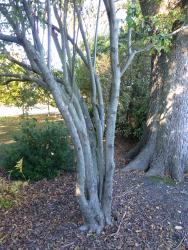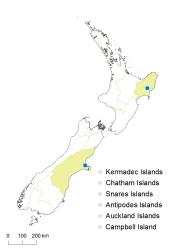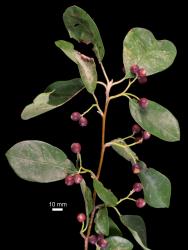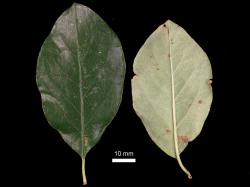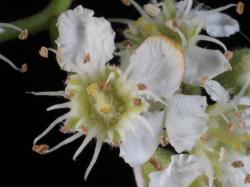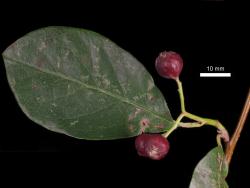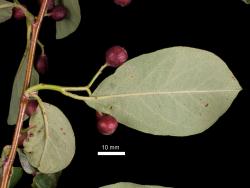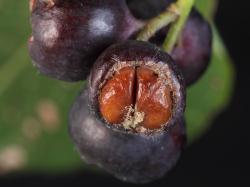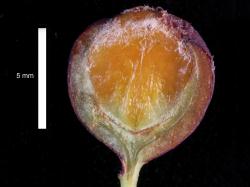- ≡ Cotoneaster affinis var. bacillaris (Wall. ex Lindl.) C.K.Schneid. (1906)
Erect tree, deciduous, to 8 m tall. Branchlets green-brown, with peeling cuticle, sparse lenticels, and dense pale yellow tomentum. Stipules 4.0 mm long, green, early-deciduous. Leaves 68–106 mm long, lamina 56–99 mm long, 33–61 mm wide, petiole 7–13 mm long with sparse to moderately dense white hairs; leaf lamina slightly obovate, plane, base cuneate to obtuse, apex round, obtuse, or emarginate, apiculus straight or curved downwards; lateral veins 5–6 pairs, midvein or midvein and lateral veins impressed on upper surface and projecting on lower surface; upper surface dark bluish-green (RHS 131A), dull to semi-glossy, with sparse white hairs when young, present in the midvein groove, glabrous when old; margins plane, hairs absent; leaf underside slightly glaucous, with sparse, fine, straight white hairs.
Inflorescence a compound corymb of 19–22 flowers, 45 mm long with 3–4 leaves. Flowers 7–10 mm diameter. Hypanthium green, with moderately dense white tomentum, sepals 2.5 mm long, 1.2 mm wide. Petals white in bud, spreading and white when open, 3.7 mm long, 3.4 mm wide, not clawed at the base, with a hair tuft, margin entire but crisped. Stamens 20, filaments 3.0 mm long, white, anthers cream, 0.9 mm long. Styles 2, 2.3 mm long. Fruit dark violet, obovoid, 7.0 mm long, 7.1 mm wide, glabrous except at pedicel and calyx. Pyrenes 2, 5.5–5.7 mm long, 4.7–5.0 wide, hairs dense at pyrene apex, stigma attached at apex.
By the black fruit with 2 pyrenes visible at the apex of the ripe fruit because of the open navel, the style at the pyrene apex, hairs rather dense on the apical half of the pyrene, flowers have white spreading petals that have a tuft of hairs at their base, anthers are purple, the tree has a single tall trunk and the leaves are deciduous.
Most similar to Cotoneaster affinis in being an erect tree, having large leaves (50–90 mm long) that are slightly glaucous and become glabrous underneath, black fruit, white spreading petals with a hair tuft near the base. Differs from that species in having purple anthers (rather than white anthers that age to purple), the style is at the apex of the pyrene rather than below the apex, and it has an open navel so that the pyrenes are visible at the fruit apex (pyrenes are not visible in C. affinis). The hypanthium of C. affinis is densely pilose-strigose, while that of C. bacillaris is sparsely pilose-strigose. Cotoneaster affinis is probably not present in New Zealand. Gaddum 2001(p. 63) states it is present in New Zealand, and some specimens at CHR were formerly identified as C. affinis but are all C. bacillaris.
Similar to C. frigidus in size and form of tree and leaf size and leaf hair distribution. Cotoneaster frigidus differs in having red, not black, fruit.
Known in cultivation in Gisborne (Eastwoodhill Arboretum), Canterbury (Woodham Park, Hororātā, Diamond Harbour).
Flowering: November, Fruiting: February onwards
Triploid based on flow cytometry of CHR 638097. Reported to be variably 2x, 3x, and 4x, possibly due to misidentifications (Fryer & Hylmö 2009, p. 81).



